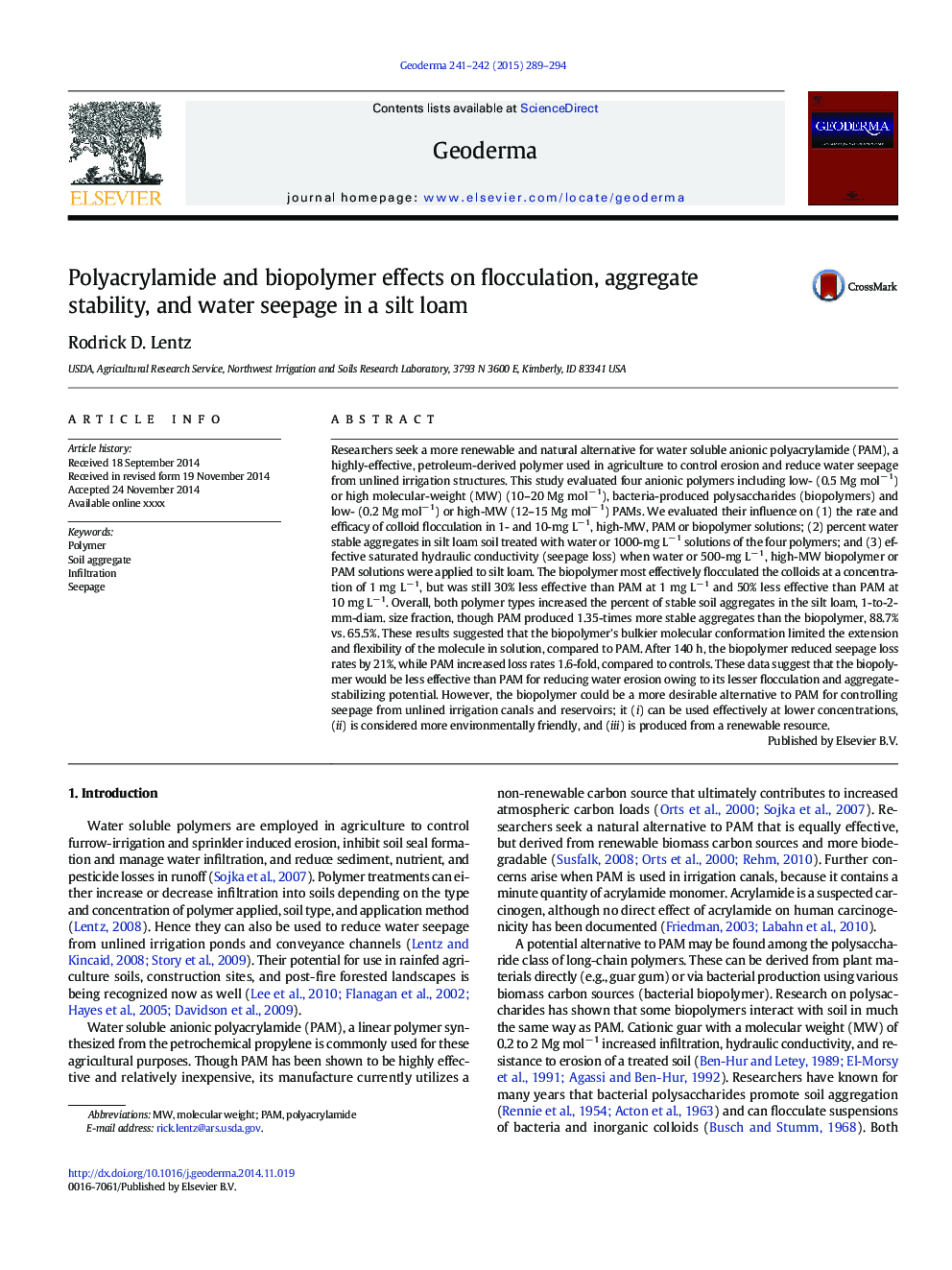| کد مقاله | کد نشریه | سال انتشار | مقاله انگلیسی | نسخه تمام متن |
|---|---|---|---|---|
| 6408620 | 1629465 | 2015 | 6 صفحه PDF | دانلود رایگان |
عنوان انگلیسی مقاله ISI
Polyacrylamide and biopolymer effects on flocculation, aggregate stability, and water seepage in a silt loam
ترجمه فارسی عنوان
اثرات پلی آکریل آمید و بیوپلیمر بر فلوکولاسیون، پایداری خاکستری و نفوذ آب در لومیت آهک
دانلود مقاله + سفارش ترجمه
دانلود مقاله ISI انگلیسی
رایگان برای ایرانیان
کلمات کلیدی
موضوعات مرتبط
مهندسی و علوم پایه
علوم زمین و سیارات
فرآیندهای سطح زمین
چکیده انگلیسی
Researchers seek a more renewable and natural alternative for water soluble anionic polyacrylamide (PAM), a highly-effective, petroleum-derived polymer used in agriculture to control erosion and reduce water seepage from unlined irrigation structures. This study evaluated four anionic polymers including low- (0.5 Mg molâ 1) or high molecular-weight (MW) (10-20 Mg molâ 1), bacteria-produced polysaccharides (biopolymers) and low- (0.2 Mg molâ 1) or high-MW (12-15 Mg molâ 1) PAMs. We evaluated their influence on (1) the rate and efficacy of colloid flocculation in 1- and 10-mg Lâ 1, high-MW, PAM or biopolymer solutions; (2) percent water stable aggregates in silt loam soil treated with water or 1000-mg Lâ 1 solutions of the four polymers; and (3) effective saturated hydraulic conductivity (seepage loss) when water or 500-mg Lâ 1, high-MW biopolymer or PAM solutions were applied to silt loam. The biopolymer most effectively flocculated the colloids at a concentration of 1 mg Lâ 1, but was still 30% less effective than PAM at 1 mg Lâ 1 and 50% less effective than PAM at 10 mg Lâ 1. Overall, both polymer types increased the percent of stable soil aggregates in the silt loam, 1-to-2-mm-diam. size fraction, though PAM produced 1.35-times more stable aggregates than the biopolymer, 88.7% vs. 65.5%. These results suggested that the biopolymer's bulkier molecular conformation limited the extension and flexibility of the molecule in solution, compared to PAM. After 140 h, the biopolymer reduced seepage loss rates by 21%, while PAM increased loss rates 1.6-fold, compared to controls. These data suggest that the biopolymer would be less effective than PAM for reducing water erosion owing to its lesser flocculation and aggregate-stabilizing potential. However, the biopolymer could be a more desirable alternative to PAM for controlling seepage from unlined irrigation canals and reservoirs; it (i) can be used effectively at lower concentrations, (ii) is considered more environmentally friendly, and (iii) is produced from a renewable resource.
ناشر
Database: Elsevier - ScienceDirect (ساینس دایرکت)
Journal: Geoderma - Volumes 241â242, March 2015, Pages 289-294
Journal: Geoderma - Volumes 241â242, March 2015, Pages 289-294
نویسندگان
Rodrick D. Lentz,
